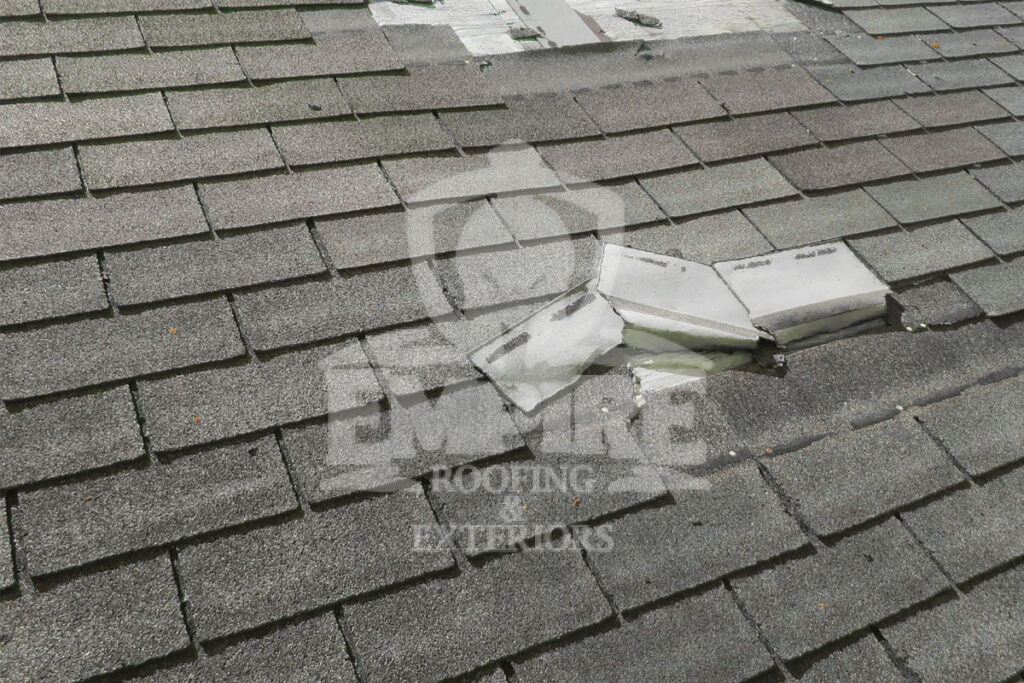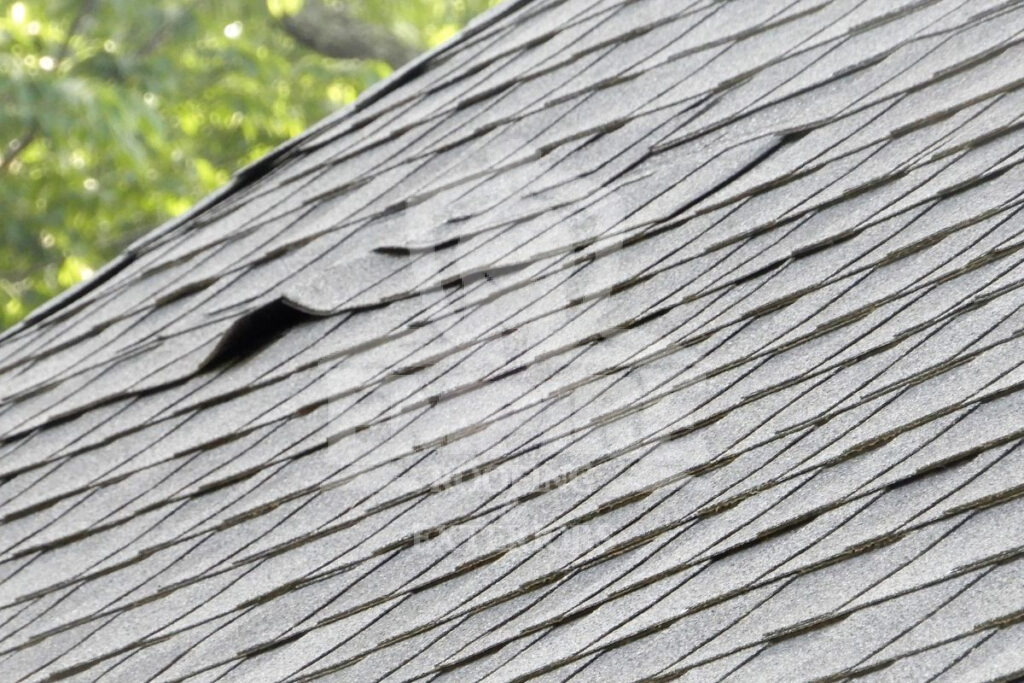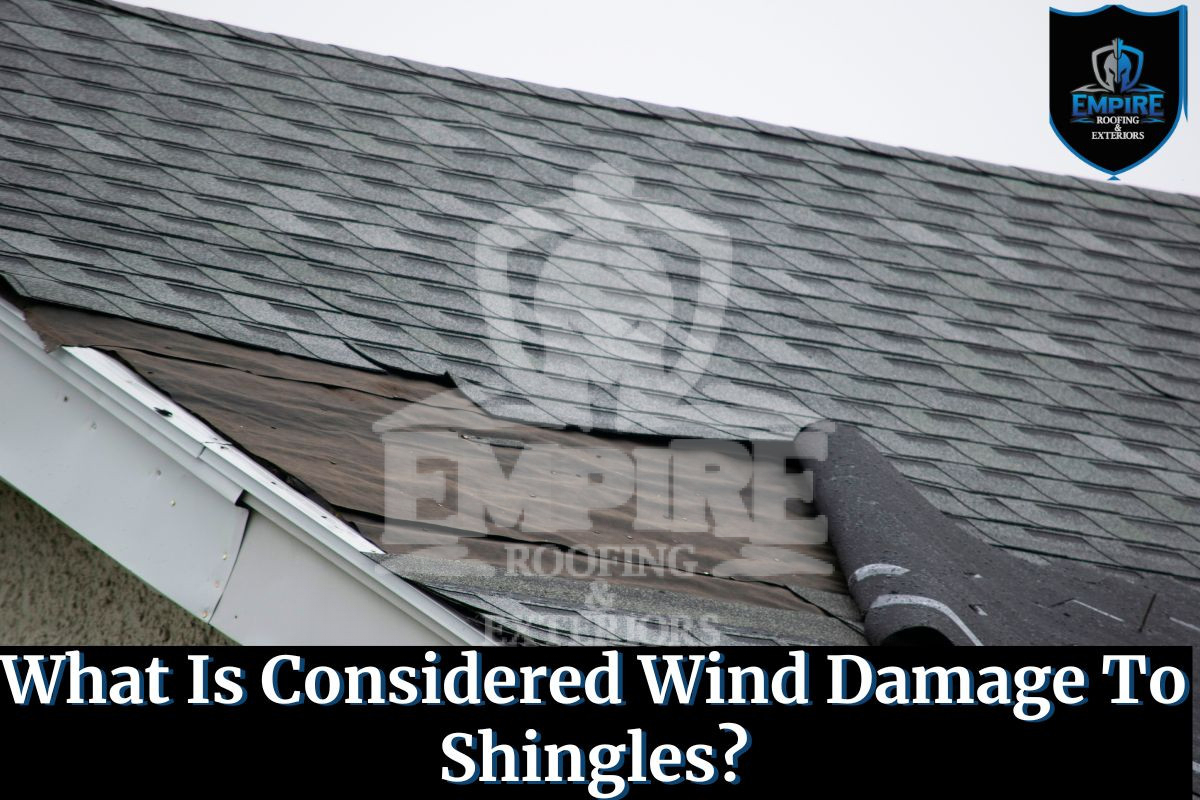When safeguarding your home, the roof holds significant importance in shielding your property against natural elements. Wind damage, particularly to shingles, stands out as a common threat that roofs encounter. It’s crucial to identify the indicators of wind damage to shingles in order to uphold your roof’s integrity and avert potential complications.
In this blog post, we will explore the concept of wind damage to shingles, the telltale signs to observe, and the consequences of disregarding this form of damage.
What Does Wind Damage Look Like On Shingles?
As a homeowner, keeping your home in the best shape is important, and that is why identifying the signs of wind damage is essential. Some of them include:
#1. Missing Roof Shingles
The most noticeable sign of wind damage is missing shingles. Your roof may be totally stripped of its shingles by strong winds, leaving portions of the roof exposed. This weakens your roof’s aesthetic appeal and increases the likelihood of water leaks and other damage.
#2. Curled Or Lifted Shingles

If shingles haven’t been ripped off the roof but are lifting up and curling around the edges, this is an indicator that the adhesive bond has been compromised, leaving your roof vulnerable.
#3. Granules Missing From Shingles
Another indicator of wind damage is the presence of granules from shingles in your gutters or downspouts. Granule loss exposes the underlying shingle material to UV rays making the shingles more susceptible to cracking and deterioration.
#4. Damaged Soffit Or Fascia
It’s important to check the fascia and soffit for damage because these elements are key in preventing water damage to your home. Wind can weaken these components, jeopardizing the structural integrity of your roof.
#5. Damaged Flashing
The flashing surrounding roof penetrations like chimneys, vents, and skylights may also be impacted by wind damage. Water can enter your home through loose or damaged flashing, increasing the possibility of leaks and interior water damage.
#6. Water Stains

Water stains on your walls or ceiling may indicate that wind has damaged your roof, allowing water to access the interior of your home. These stains show that water has seeped into your roof, emphasizing how urgently you need to fix the problem.
#7. Loose Or Exposed Nails
A thorough inspection is necessary for loose or exposed nails, as these may be signs of wind-related shingle damage, which could result in water infiltration and structural problems.
#8. Dents And Bruises
Wind can cause debris such as twigs and sticks to hit your home, leaving behind dents or bruises that represent impact damage, which weakens the shingles and increases their susceptibility to leaks and additional deterioration.
What Factors Affect The Severity Of Wind Damage?
1. Wind and Roof Interaction
- Wind Patterns: Wind movements are non-uniform, influenced by factors like topography, terrain, temperature, and atmospheric pressure.
- Uplift Pressure: Wind hitting a home creates uplift pressure, which occurs most severely along roof corners and edges, making them vulnerable.
- Negative Pressure: Wind across the roof creates negative pressure, leading to shingle uplift and potential damage.
2. Location
- Regional Weather: Homes in hurricane and tornado-prone regions face a higher risk of wind damage.
3. Roof Design
- Type: Gable roofs with wide overhangs are more vulnerable to wind uplift compared to hip roofs.
4. Installation
- Fasteners: The strength and placement of nails impact a roof’s wind resistance.
- Quality: Poorly installed roofs are more prone to weather-related issues.
5. Roof Condition
- Age and Wear: Older roofs with visible damage are more vulnerable to damage.
- Pre-Existing Damage: Roofs with issues like missing flashing are at higher risk of damage.
Does Homeowners Insurance Cover Wind Damage To Shingles?
Yes, wind damage to shingles is normally covered by homeowners insurance if it results from a strong storm. Most homeowners insurance policies will probably cover the cost of replacing or repairing the shingles if they are blown off as a result of an abrupt, unplanned event like a windstorm.
Nevertheless, coverage might not be applicable if the damage results from normal wear and tear, inadequate maintenance, or pre-existing conditions. Review your individual policy to find out what is covered, and get in touch with an experienced roofing contractor to learn what’s best for your specific situation.
How To Prevent Wind Damage To Shingles
To mitigate wind damage to shingles, follow these essential steps:
- Ensure Quality Installation: Properly nail shingles to the roof deck to avoid weak points vulnerable to wind damage.
- Select Resilient Materials: Opt for wind-resistant materials to bolster your roof’s ability to endure strong winds.
- Perform Regular Maintenance: Conduct frequent roof inspections to promptly address any necessary repairs. Trim overhanging tree branches and enlist certified roofing professionals for installations and repairs.
- Fortify the Structure: Strengthen the roof by securing trusses, adding bracing, and installing hurricane straps to anchor it firmly to your property’s walls.
How To Fix Wind Damaged Shingles

1. Assess Damage
Visually inspect your roof for cracked, torn, or missing shingles to determine the extent of the damage.
2. Remove Damaged Shingles
Gently lift damaged shingles and remove nails holding them in place, taking care not to damage surrounding shingles.
3. Install Replacements
Replace damaged shingles with matching ones, ensuring a snug fit.
4. Seal Shingles
Apply roofing cement to the edges and bottoms of new shingles for a watertight seal.
5. Secure with Nails
Fasten new shingles with roofing nails, ensuring they’re flush with the surface to prevent lifting.
6. Perform Checks
Inspect the repair for proper installation and sealing and consider professional help for extensive damage.
Repair Your Wind Damaged Roof With The Team At Empire Roofing & Exteriors
For homeowners, wind damage to shingles can pose a serious risk since it can result in expensive repairs and interior water damage. Preserving the integrity of a roof requires an understanding of the nuances of wind damage, quick detection, and proactive measures.
Homeowners facing the uncertainty of wind damage trust Empire Roofing & Exteriors’ storm damage services to provide complete protection against the aftermath of a storm, which provides peace of mind during times of need. With over 90 5-star reviews, 30 years of combined experience, and a 10-year workmanship warranty, we are a dependable partner for protecting homes from wind damage. Give us a call today at (225) 347-8877 to speak with one of our experts and find out how we can help you.
